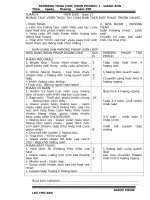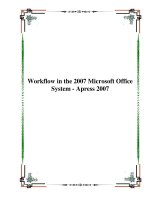Tài liệu Instrumentation in the brewing industry Automation of the brewing process pot
Bạn đang xem bản rút gọn của tài liệu. Xem và tải ngay bản đầy đủ của tài liệu tại đây (2.56 MB, 16 trang )
Instrumentation in the brewing industry
Automation of the brewing process
2
3
Brewing beer means to deal with natural
grown products changing from year-to-year,
harvest-to-harvest. The brewer needs to
react on these changes to prepare a stable
quality of beer, and even more, it must taste
the same all year, each and every year, to
fulfill the expectation of the customer. To
follow this moving target, a lot of experience
is necessary. It is the art of brewing.
Endress+Hauser is here to help you run
your process consistently on a high quality
level every day and night. Throughout this
document you will find how state of the
art sensor technology supports the brewing
process. Rising accuracy of process sensory,
along with high repeatability enables the
user to run a process in the most efficient
manner. Optimized raw material use,
energy conservance and best availability
of the plant is the target of automation.
The art of Brewing
Instrumentation for:
• Malting
• Malt and grain storage
• Brewhouse
• Fermentation
• Filtration
• Packaging
• CIP and water preparation
• Boiler
• CO
2
and natural gas
Supporting the cleaning process is a
basic requirement to save time and energy.
All shown sensors are developed to work
in hygienic processes. They follow the
guidelines of FDA, 3-A and EHEDG.
Reliable measurement supplies the necessary
data for the ideal process, and supports suitable
solutions for tracking and tracing the beer.
4
Silos can be easily mapped for
fast commissioning and reliable
measurement.
Levelflex
FMP40
Micropilot
FMR250
Soliphant M
FTM50
Solicap M
FTI55
Energy conservation
Blocked dust filters can be a
safety hazard and can also cause
unnecessary energy consumption.
Pressure transmitters with
ceramic membrane provide
reliable and cleanable option to
conventional metal membranes.
The PMC45 offer cost effective
solution for dust hazardous area.
Malt/grain inventory silos
Complete inventory management
solutions to address rising inventory
costs are easily realized with complete
packages from Endress+Hauser.
freespace (FMR250) or guided wave
radar (FMP40) provide an option
to select the best-fit to address
measurement challenges due to silo
height, diameter and amount of dust.
Continuous level measurement
in malt silos
View of levelflex cable
Malt and grain storage
Reliable and visible inventory status
5
Inventory and supply chain management
Rising commodities drives the need for real-time information
Safety precautions with level alarms
Reliable High/Low level alarms
for silos and hoppers are critical for
any application. Chose between
Capacitance (FTI51) or tuning fork
(FTM50) depending on installation point.
Accounting of bulk inventory kept in tanks and silos has
traditionally not had high priority. This is particularly true
for bulk material such as sugar, flour and grains. However,
with the rapidly rising value of these commodities it is
becoming more and more important to have a current
status of inventory levels to allow for planning and
advanced purchasing techniques.
Endress+Hauser can provide scalable, turnkey solutions
for your plant with simple, local monitoring or full
integration into your ERP system. Installation costs can be
kept to a minimum using wireless solutions or Ethernet
connection. Solutions are available for single or multiple
site applications.
Infrastructure - In Plant Monitoring or Remote Sites
Intranet/ERP Integration
Data visibility
for our CUSTOMER
Ethernet/Land line/GSM/GPRS for
connection of remote location
Installation at our
Customer location
Ethernet
6
Brewhouse
Optimizing the yield and quality of extract production
Mash tun level
The Mash tun level is
measured with highest
reliability with the
temperature compensated
FMB70 hydrostatic level
sensor. Remote electronics
make access easy.
Promag H series: great
value for the money
Foundation water for mash
tun need to be metered
accurately.
Wort kettle pressure
Energy conservation is
achieved by applying
pressure to wort kettle.
The Cerabar M pressure
transmitter is ideal for this
application - simple and
reliable pressure control.
Boiling
In-line extract measurement
with Liquiphant Density
ensures stable wort quality,
along with optimized energy
use during wort boiling.
Lauter tun wort
clarity performance
A critical control point for
the Lauter tun is the outflow
turbidity and density.
Turbidity is monitored by the
optical sensor AF12-ER.
7
Mash and foundation water
pH must be monitored closely to
achieve best yield in mash tun.
Non-glass IsFet pH (CPS441D/
CPS471D) sensor and retractable
holders combined with Memosens
technology brings highest
reliability and accuracy.
Energy and extract loss reduction
To avoid wasting extract, lauter
systems are monitored with
Promass F. Stopping the flush
water at the exact right
moment optimizes ingredients
and saves energy during the boil.
Reliable level in silo
Overfilling the spent grain silo
is a big mess. Avoid this
situation with reliable level
measurement using free space
radar Micropilot FMR245.
Adjuncts, dextrose
and enzymes
Adjuncts and dextrose must be
added with high accuracy to
optimize raw material usage.
The Promass 83S provides the
best temperature stability and
accurate measurement available
today. Combine this with the
possibility to ensure performance
between calibrations using the
FieldCheck verification tool.
Lautertun bed density
Differential pressure across the
lautertun bed is commonly using
pressure transmitters with metal
membranes. Due to the abrasive
nature of the mash and cleaning
procedure the membranes are
often damaged. The PMC71
ceramic membrane pressure
transmitter provide reliable and
highly accurate alternative.
Steam supply
Accurate measurement of the
steam supply for the mash tun
and wort kettle is used to identify
fouling and can have a direct impact
on energy cost. Prowirl 73 with
steam computer gives you direct
BTU readings.
Brewhouse
8
Fermentation
Consistent quality batch-after-batch
Wort aeration
The goal in fermentation is to produce
alcohol. Based on the condition of the
yeast, oxygen supply level is controlled,
using COS21D, allowing the yeast to
populate at an optimal rate.
Sterile air supply
Sterile air supply to wort aeration is
best done with a thermal massflow
meter. The t-mass series is capable of
highly accurate measurements with a
large turndown range.
9
Level measurement
Level measurement of fermentation,
aging and bright beer tanks are
done using the highly accurate and
temperature compensated FMB70
hydrostatic level transmitter.
Electronic differential pressure
compensate for CO
2
head pressure.
Extract measurement
Extract measurement in the
fermentation vessel with
Liquiphant Density ensure a
stable fermentation process by
allowing continuous adjustment,
as needed by the actual brew.
Empty pipe - high/low tank level
or detection of foam in CO
2
line
The Liquiphant M is a universal
switch with no need for calibration or
adjustment throughout the lifecycle
of the instrument. Version is available
tuned to detect foam in CO
2
line.
Yeast dosing
The amount of yeast is measured
with a magnetic flowmeter
Promag H combined with
an optical turbidity sensor
OUSAF12-ER to monitor the
cell concentration.
Fermentation
Level measurement
CO
2
storage tank level must be
monitored closely to ensure uninterrupted
supply. Levelflex M FMP40 guided wave
radar provides a set-and-forget alternative
that eliminates the need for periodic
calibrations. The coaxial probe is ideal.
Rod or cable can be used in combination
with patented “end-of-probe”function.
Temperature measurement
Reliable temperature measurement
is key throughout the brewing
process and utilities. Highest
quality RTDs combined with
fast response tips ensure optimal
temperature control.
10
Dissolved Oxygen measurement
Examples are for trim cooler output,
degasser, packaging release and in
carbonation stage. The COS21D DO
sensor provide reliable measurement
with minimal maintenance.
Liquid storage or transfer tank
Point level detection in any liquid
storage or transfer tank is done reliably
without the need for any calibration
with the tuning fork point level switch
Liquiphant FTL50H.
Degassed water
pH of the degassed water must be
monitored closely. Non glass IsFet
pH (CPS471D) sensor and retractable
holders, combined with Memosens
technology, brings highest reliability
and ensures purity of water.
Conventional glass electrodes are
also available.
Filtration
Production of a consistent product with minimal beer loss
Flash pasteurizer
temperature control
Fast response time is
needed for stable control
High gravity blending
Minimize beer loss with
combination of high performance
metering - Promag 53H on water
and Promass 83S for combined flow
including extract (Plato°) value.
Filter performance
Differential pressure is a common
indicator for filter performance.
Conventional DP transmitter FMD78
or electronic DP with PMC45 provide
needed reliability. Optical sensors can
be used for breakthrough alarm.
11
Boundary or “taxation meter”
Require documented
traceable periodic verification
of performance. FieldCheck
verification tool is easily used
to ensure performance and generate
documentation that meet 27CFR
part 25 for the Promag 53 magnetic
flowmeter between calibrations.
Product identification
prior to packaging
Conductivity is monitored
throughput the process. A
key measurement is on the
packaging release tank.
Conductivity sensor CLS54 is
used to verify that the expected
product is in the line. This
can be combined with optical color
measurement for added safety.
Bright beer tank
Highest accuracy is needed
to plan for bottling line
free space radar FMR245
or hydrostatic level sensor
FMB70 provide this key
information.
Washdown
To ensure sterility and food
safety during filling the
whole area is often washed
down with strong
detergents/sanitizer.
All instruments are IP67
or better to ensure life in
washdown environment.
Packaging
Keep consumers happy with clean, crisp product
Bottle and keg washing
Sanitizer concentration must
be monitored to ensure
optimal cleaning efficiency.
Endress+Hauser offers a full line
of analytical sensors (for example,
for chlorine dioxide the CCS240
chlorine dioxide sensor works
at low flow rate, require no zero
point calibration and is not affected
by conductivity fluctuations.
Fillerbowl level
To ensure complete fills
and avoid beer losses the
fillerbowl level must be
measured accurately. The
FMI51 capacitance level sensor
provide best accuracy under
the fast moving conditions.
12
CIP optimization
Key process for quality, safety and yield
CIP concentration
CIP concentration is critical to the food
safety but also have big impact on use of
detergent and energy cost for heating
CIP circuit. The CLD134 conductivity
transmitter have the fastest temperature
compensation on the market and offer
dual range capability. Ultrafast temperature
compensation ensures best-in-class performance.
Secure records
CIP records are kept secure in
video graphic recorders capable
of meeting 21CFRpart 11.
Beer loss reduction
Fast and effective interface/phase
separation is key for reducing beer
and water losses. The AF11 can help
you save large amounts from going
down the drain. Saving you not only
in product losses but also in water
treatment costs.
CIP make-up and chemical
tank inventory
Level measurement for inventory or
process control of aggressive chemicals
is solved by multiple options depending
on tank size and user preference -
capacitance, ultrasonic or freespace
radar are most common.
13
WAGES – Water, Air, Gas Electricity & Steam
Make a difference to the
environment and the bottom line
The starting point for any conservation
program is to know where you stand
today and then identify potential areas
for improvement. For example; do you
really need a larger air compressor
or can you reduce the air usage? By
applying simple permanent or temporary
measurements you can make qualified
decisions based on facts.
Endress+Hauser is in a position to
help you monitor your resources to
ensure success of your conservation
initiatives. One of our clients in the
brewing industry, have reduced overall
energy consumption (WAGES) by over
300% since implementing a monitoring
program in 2006.
Activity –
Setting energy targets
They now, for example, measure and
recover over 90% of all CO
2
and have
reduced overall water consumption and
natural gas usage.
Typical WAGES monitoring in a brewery
involve steam measurement to monitor
overall efficiency and to detect problems
with steam traps. Vortex flowmeter
combined with steam computer gives you
direct energy readout.
Water consumption is a big issue in the
brewing industry, way too much water
is wasted in inefficient cleaning and
washdown procedures, a simple magnetic
flowmeter or a temporary clamp-on
ultrasonic flowmeter will help you keep
track while making improvements.
Compressed air – a ¼” leak will cost
over $8000 in energy losses. Monitoring
of pressure or flow using thermal mass
flow or Vortex flow meters can help
identify leaks and usage during active
and idle periods.
CO
2
and natural can both be measured
with DP flow or Vortex but more and more
opt for entry level Coriolis flowmeters
that provide highest accuracy and direct
reading in massflow without the need for
additional compensation
Measurement information is collected
and presented in easy to use program
for trending and planning purpose.
Immediately see the result of your
conservation programs and identify
where the next opportunity is.
14
Wastewater treatment
Reduced production losses = reduced cost of wastewater treatment
Step 1
Identify when and what is coming down
the drain. A simple optical sensor CUS41
mounted in the drainpipe can immediately
identify a spill and the amount of solids
(nutrients). Use this to implement a plan to
reduce accidental spills and feed forward
control for treatment plant.
By implementing in-line quality
control with checks and balances the
beer losses can be kept at a minimum.
However, even in the best conditions
there will be wastewater generated.
By applying simple measurement and
controls the cost of water treatment
can be minimized.
Step 2
pH balance, depending on the size of the
plant and the local arrangement with your
municipal treatment plant you may only
need to monitor and balance the pH value.
pH sensors in conventional glass or non-glass
combined with the Endress+Hauser patented
Memosens technology ensure maximum
reliability and low maintenance.
Step 3
The wastewater in a brewery has very high
nutrient content (BOD) due to the alcohol,
yeast and fermentable solids. By monitoring
dissolved oxygen (DO), turbidity and possibly
TOC the treatment process can be optimized.
Example is use of DO in aeration tanks to
effectively reduce BOD levels while only
running the blowers at most energy efficient
levels. Blower air is easily monitored with
thermal or vortex shedding flowmeters.
Step 4
Final effluent, depending on your level
of environmental consciousness and the
city/state regulations you need to monitor
and keep records of outgoing volume and
residual nutrients. Electromagnetic or
ultrasonic flowmeters are commonly used
in combination with pH, DO, Chlorine and
at times a TOC analyzer, all captured in an
electronic record such as the videographic
recorder Memograph M. Records can be
managed in accordance with 21CFR part 11
and is easily shared with authorities.
15
Calibration and instrumentation maintenance
Focus on your core competence - outsource the rest to the experts
On-site calibration of flowmeters
using mobile flow rig
On-site calibration of
pressure devices
Laboratory calibration of
level instruments
On-site calibration of
analysis devices
On-site calibration of
temperature instruments
Discussion around the
metrology plan
SOPs, calibration certificates,
labels and electronic recordings
Predictive maintenance and properly executed calibrations
are becoming more important as tools to maintain beer
quality, reduce downtime and to be in compliance with
consumer driven as well as regulatory demands.
Verification of Taxation meters
Depending on the country and size of annual production
there are requirement to document how much beer is
produced. To ensure accuracy of reported production
volume, calibration or verification documentation of the
flowmeter is required. For example, in USA, the Alcohol
Taxation is governed by the US Department of Treasury
Alcohol and Tobacco Tax and Trade Bureau (TTB). The TTB
requirements are defined in 21CFRpart 25.
Endress+Hauser provides the option to do a wet calibration
or a flowmeter verification that meets the TTB document
requirements. Using the FieldCheck verification tool which
is traceable to NIST standards a fast on-site verification is
done without removing the meter from service, reducing
downtime and labor costs.
Instrumentation today offers a wide range of onboard diagnostics
that can tell you if a device is in need of a check-up. Unfortunately,
many times these functions are not used to their full capability. Let
Endress+Hauser help you reach the full potential.
Calibration or Verification and diagnostics, terms often misunderstood
• Calibration = Comparison of performance parameter against a
traceable reference
• Verification = Test of electronics or sensor with signal simulator.
Simulator should be traceable to recognized standard
• Diagnostics = Onboard or external self check of key performance
parameters and signal values that show health of sensor and
transmitter
SO008B/24/ae/02.10
US/INDD CS2
Liquid Analysis
• Conductivity
• pH/ORP
• Chlorine
• Dissolved oxygen
• Turbidity
• Chemical analyzers
• Nitrate/organic sensors
• Sludge level
• Sampling stations
Recorders
• Paperless recorders
• Visual data managers
• Safety data managers
• Displays
• Barriers
• Power supplies
Solutions
• Wireless networks
• Inventory control
• Energy monitoring
• Tank farm monitoring
• Life cycle management
• Plant asset management
• Flow management solutions
• Wastewater treatment optimization
Service
• Start-up
• Training
• Calibration
• Maintenance contracts
• Installed base audit
Level
• Capacitance (RF)
• Conductive
• Mechanical
• Vibration
• Ultrasonic
• Radar
• Guided radar (TDR)
• Hydrostatic
Pressure
• Gauge/absolute
• Differential pressure
• Hydrostatic
Flow
• Electromagnetic
• Vortex shedding
• Coriolis mass flow
• Ultrasonic
• Open channel
• D/P flow
• Thermal mass flow
www.ie.endress.com/e-direct
• Shop on-line for low-cost
instruments, devices and
components
Endress+Hauser’s product portfolio
Temperature
• Temperature transmitters
• RTDs/thermocouples
• Sensors
Canada
Endress+Hauser Canada
1075 Sutton Drive
Burlington, ON L7L 5Z8
Tel: 905-681-9292
800-668-3199
Fax: 905-681-9444
www.ca.endress.com
Ireland
Endress+Hauser (Ireland) Ltd
Clane Business Park
Clane
Tel: +353 (0) 45 86 86 15
Fax: +353 (0) 45 86 81 82
www.ie.endress.com
ISO 9001:2000 Certified
02.10/SC USA









